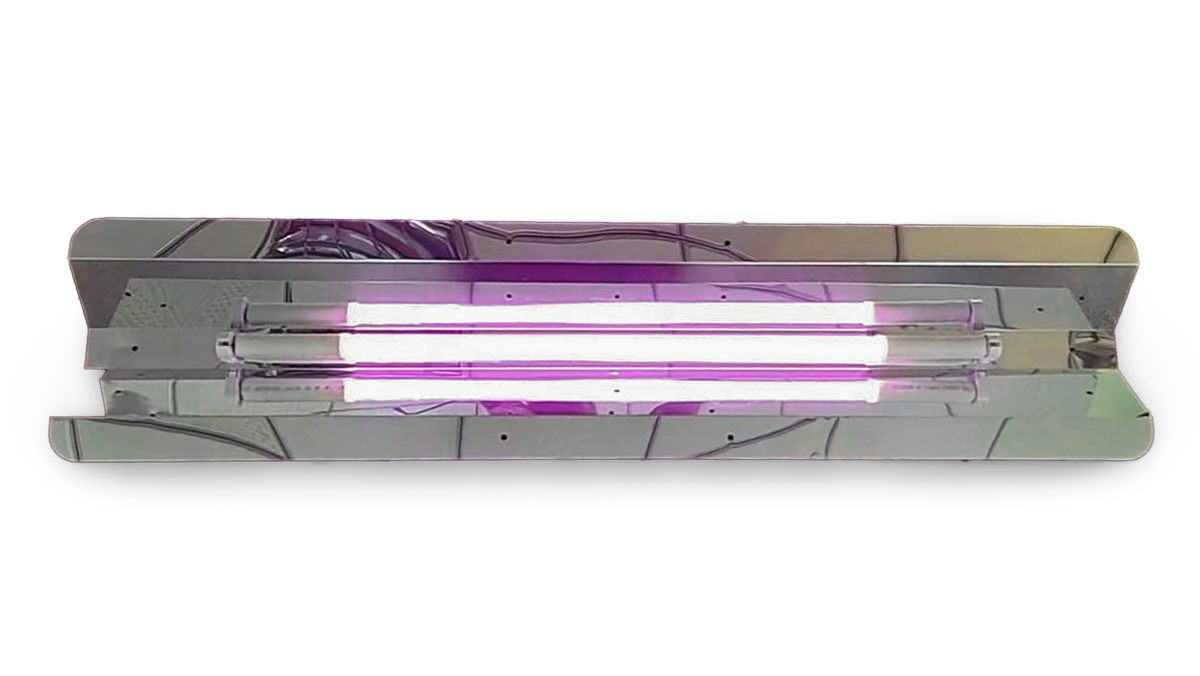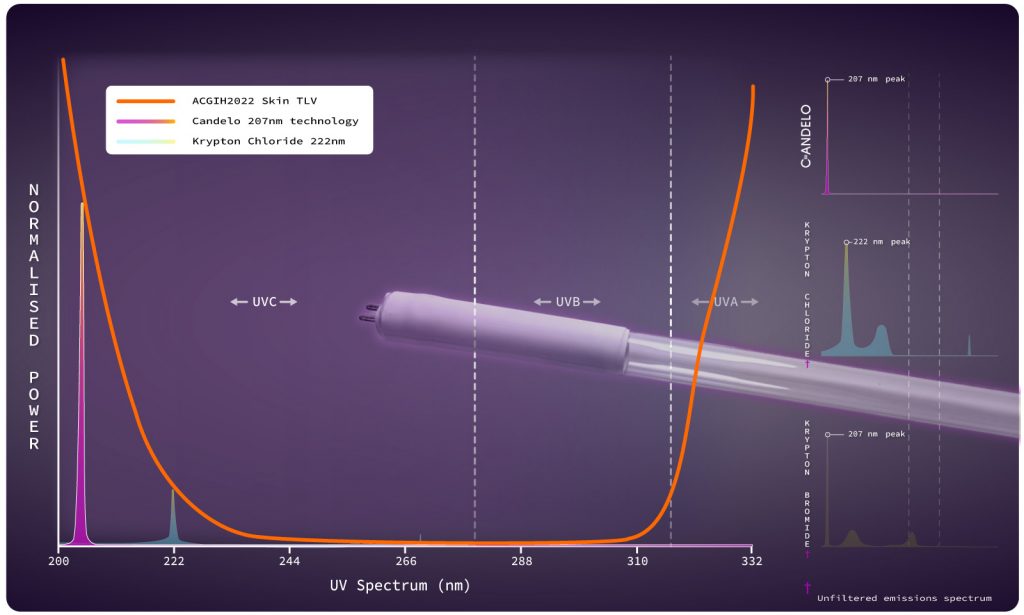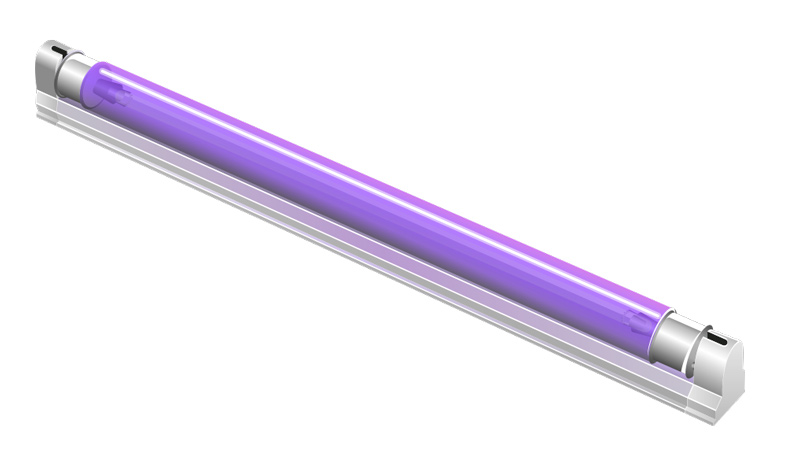
The future of Far UVC
There’s a lot of excitement about the potential of Far UVC lighting for widespread use in a variety of settings where higher wavelengths (primarily 254 nm) are unsuitable due to concerns of impacts on human health. The ACGIH – a prominent professional organisation outlining standards for occupational and environmental health – recently confirmed that we can tolerate much higher levels of Far UVC without damage to the skin or eyes compared to legacy 254 nm technology. This is particularly true for lights emitting at 207 nm, where the threshold limit value (TLV) is up to 8 times higher than at 222 nm, the other main Far UVC wavelength.
Recent laboratory-based studies on the ability of Far UVC lamps to deactivate viruses (including SARS-COV2) have shown that lower wavelength lamps were even more germicidally effective than the higher wavelengths tested. Far UVC, in particular 207 nm-based solutions, are emerging as the best option in UV air and surface disinfection – a technology that quickly kills viruses like the Coronavirus before they infect others while also being safe for prolonged use in occupied spaces.
Filter-free 207 nm Far UVC
Despite its massive potential, Far UVC lighting technology is very much in its infancy with only one formulation – Krypton Chloride (KrCl) 222 nm excimer lamps – having been properly commercialised. Krypton Bromide (KrBr) lamps have been shown to emit at 207 nm but are not available for purchase due to a number of production issues. Both these Krypton-based excimer lamps are prohibitively expensive for most users because they require costly filters to eliminate unwanted secondary spikes along the UV band.

Enter Candelo’s patented filter-free Far UVC technology. We have discovered a unique gas formulation that emits at 207 nm without any harmful UV emissions.

The above graph shows how the markedly higher allowed dose of 207 nm vs 222 nm (KrCl) according to the recently updated ACGIH TLVs enables the power output to be much higher, delivering enhanced germicidal efficacy within the safe range for human exposure.
The 3 smaller graphs on the right-hand side depict the unfiltered spectra of our technology – with its solitary 207nm emission without any filtering – as well as the emissions profile of the Krypton excimer options. As the graphs show, KrCl lamps emit a significant secondary spike around the 250-260 nm range which needs to be eliminated by adding a costly bandpass optical filter. These not only block out the unwanted UVC output, but also significantly reduce the efficiency of the desired 222 nm Far UV. KrBr on the other hand, which has up until now been the primary way to generate 207 nm UVC in laboratory conditions, also requires filtering to remove its harmful emissions at higher wavelengths.
Candelo’s patented technology delivers the safest and cleanest Far UV light source to date, with a strong emission profile at 207nm and no unwanted secondary or tertiary spikes.
Why 207nm is the future of Far UVC
Our safe, cost-effective and scalable 207 nm lighting solution represents a breakthrough in Far UVC technology that will power a range of use cases and applications previously unimaginable due to cost and safety concerns. Emerging evidence from the scientific community is confirming that human tissue is far more tolerant of lower wavelength UVC in the 207-222 nm range when compared to UVC light in the 230-280 nm range. In the past, 254 nm ultraviolet germicidal irradiation (UVGI) technology been commercially confined to niche markets like hospital operating rooms, water purification plants and enclosed HVAC applications, largely due to (often unfounded) safety concerns.
A groundbreaking 2021 study published by the American Society for Microbiology shows that in addition to being safer than UVC higher UVC wavelengths, Far UVC is also proving more germicidally effective – significantly, more effective at inactivating the SARS-CoV-2 virus.

In fact it appears the lower on the spectrum of the UVC light source, the better it is tolerated by people yet the worse it is for viruses and other microbes. Talk about a win-win situation!
Additional features and benefits of our technology
In addition to delivering the first Far UVC lamp that does not require an expensive filter, there are a number of other advantages our Far UVC bulb design offers over other solutions including Krypton Chloride and 254nm mercury vapour lamps.

With a precise 207 nm UVC emission profile, Candelo’s technology generates the safest Far UVC wavelength coupled with the best germicidal efficacy. End-users can switch it on with peace of mind that it is safely inactivating airborne viruses in real-time.

Mercury vapour 254 nm lamps might last up to 10,000 hours, a lifetime matched only by only the most expensive Krypton Chloride lamps, which face the issue of the chlorine gas seeping into the quartz tube, degrading performance. Our technology utilises a stable inductive electrode design that can achieve up to 50,000 hours of operation.

The beauty of our invention is that it combines widely available materials with a simple yet elegant design, making it relatively low-cost. No need for expensive optical filters opens up a whole new world of possibilities for the fair and ubiquitous distribution of our technology to the globe.

UV emissions below 200 nm produce ozone, a highly reactive gas that can cause respiratory and other adverse health reactions if breathed in. Candelo’s Far UVC lamps do not emit at or below 200 nm, so you can breathe easy that no ozone is being generated.

This graph shows a variety of data derived from two recent publications:
- The ACGIH’s recent 2022 update on threshold limit value (TLV) for exposure to UVC light across the UV spectrum, with separate plots for both skin and eye exposure. The skin TLV is more relevant as for practical reasons, direct eye exposure is relatively limited in the field (people don’t generally stare directly at light bulbs for very long).
- Findings of a 2021 study published by the American Society for Microbiology, in which a range of UVC lamps were tested for their ability to inactivate SARS-COV-2 and a number of other viruses. The results suggest a direct linear relationship for increased rates of viral inactivation efficacy the lower down the UVC wavelength the light source.
Note that the points on the straight dark line marked with dashed circles for 222nm, 254nm and 282nm (the wavelengths of lamps directly observed in the study) correspond to the values in millijoules (mJ) per cm2 on the right-hand Y axis, whereas the TLV plots in orange and green for skin and eyes respectively correspond with the values in joules (J) per cm2 on the left-hand Y axis. So, for example, in the case of 222nm UVC, the ACGIH skin daily TLV is around 0.4 J/cm2 (or 400 mJ/cm2) but the inactivation rate for SARS-CoV-2 is just a fraction over 2 mJ/cm2. Essentially, for this wavelength of UVC a person will only theoretically feel adverse effects of the light on their skin at a dose 200 times that required to kill the virus.